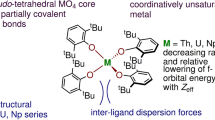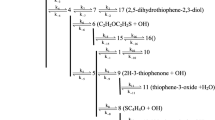Abstract
The physics and chemistry of the actinide elements form the scientific basis for rational handling of nuclear materials1,2,3. In recent experiments4, most unexpectedly, plutonium dioxide has been found to react with water to form higher oxides up to PuO2.27, whereas PuO2 had always been thought to be the highest stable oxide of plutonium2,3. We perform a theoretical analysis of this complicated situation on the basis of total energies calculated within density functional theory5,6 combined with well-established thermodynamic data. The reactions of PuO2 with either O2 or H2O to form PuO2+δ are calculated to be endothermic: that is, in order to occur they require a supply of energy. However, our calculations show that PuO2+δ can be formed, as an intermediate product, by reactions with the products of radiolysis of water, such as H2O2.
This is a preview of subscription content, access via your institution
Access options
Subscribe to this journal
Receive 12 print issues and online access
$259.00 per year
only $21.58 per issue
Buy this article
- Purchase on Springer Link
- Instant access to full article PDF
Prices may be subject to local taxes which are calculated during checkout

Similar content being viewed by others
References
Brooks, M.S.S., Johansson, B. & Skriver, H.L. in Handbook on the Physics and Chemistry of the Actinides Vol. 1 (eds Freeman, A.J. & Lander, G.H.) 153–269 (North-Holland, New York, 1984).
Keller, C. in Comprehensive Inorganic Chemistry Vol. 5 Actinides (eds Bailar, J.C., Emeleus, H.J., Nyholm, R. & Trotman-Dickenson, A.F.) 219–276 (Pergamon, Oxford, 1973).
Morss, L.R. in The Chemistry of the Actinide Elements 2nd edn Vol. 2 (eds Katz, J.J., Seaborg, G.T. & Morss, L.R.) 1278–1360 (Chapman and Hall, London, 1986).
Haschke, J.M., Allen, T.H. & Morales, L.A. Reaction of plutonium dioxide with water: formation and properties of PuO2+x Science 287 285–287 (2000).
Hohenberg, P. & Kohn, W. Inhomogeneous electron gas. Phys. Rev. 136, B864–B871 (1964).
Kohn, W. & Sham, L.J. Self-consistent equations including exchange and correlation effects. Phys. Rev. 140, A1133–A1138 (1965).
Christensen, H. & Sunder, S. Current state of knowledge of water radiolysis effects on spent nuclear fuel corrosion. Nucl. Technol. 131, 102–123 (2000).
Haschke, J.M., Allen, T.H. & Morales, L.A. Surface and corrosion chemistry of plutonium. Los Alamos Sci. 26, 252–273 (2000).
Haire, R.G. & Haschke, J.M. Plutonium oxide systems and related corrosion products. Mater. Res. Soc. Bull. 26, 689–696 (2001).
Haschke, J.M. & Oversby, V.M. Plutonium chemistry: a synthesis of experimental data and a quantitative model for plutonium oxide solubility. J. Nucl. Mater. 305, 187–201 (2002).
Haschke, J.M. & Allen, T.H. Equilibrium and thermodynamic properties of the PuO2+x solid solution. J. Alloy Compd 336 124–131 (2002).
Eriksson, O., Becker, J.D., Balatsky, A.V. & Wills, J.M. Novel electronic configuration in δ-Pu. J. Alloy Compd 287, 1–5 (1999).
Savrasov, S.Y. & Kotliar, G. & Abrahams, E. Correlated electrons in δ-plutonium within a dynamical mean-field picture. Nature 410, 793–795 (2001).
Kudin, K.N., Scuseira, G.E. & Martin, R.L. Hybrid density-functional theory and the insulating gap of UO2 . Phys. Rev. Lett. 89, 266402 (2002).
Abrikosov, I.A. & Skriver, H.L. Self-consistent linear-muffin-tin-orbitals coherent-potential technique for bulk and surface calculations: Cu–Ni, Ag–Pd, and Au–Pt random alloys. Phys. Rev. B 47, 16532–16541 (1993).
Abrikosov, I.A., Simak, S.I., Johansson, B., Ruban, A.V. & Skriver, H.L. Locally self-consistent Green's function approach to the electronic structure problem. Phys. Rev. B 56, 9319–9334 (1997).
Ruban, A.V. & Skriver, H.L. Calculated surface segregation in transition metal alloys. Comput. Mater. Sci. 15, 119–143 (1999).
Perdew, J.P. & Wang, Y. Accurate and simple analytic representation of the electron-gas correlation energy. Phys. Rev. B 45, 13244–13249 (1992).
Vitos, L., Johansson, B., Kollár, J. & Skriver, H.L. Exchange energy in the local Airy gas approximation. Phys. Rev. B 62, 10046–10050 (2000).
Perdew, J.P., Burke, K. & Ernzerhof, M. Generalized gradient approximation made simple. Phys. Rev. Lett. 77, 3865–3868 (1996).
Skriver, H.L., Andersen, O.K. & Johansson, B. 5f-electron delocalization in americium. Phys. Rev. Lett. 44, 1230–1233 (1980).
Chase, M.W. et al. JANAF Thermochemical Tables 3rd edn Part II Cr-Zr, 927–1856 (AIP, New York, 1985).
Barin, I., Knacke, O. & Kubaschewski, O. Thermochemical Properties of Inorganic Substances. (suppl.) 1–861 (Springer, Berlin, 1977).
Villars, P. & Calvert, L.D. Pearson's Handbook of Crystallographic Data for Intermetallic Phases 2nd edn (ASM International, Materials Park, Ohio, 1991).
Skorodumova, N.V., Simak, S.I., Lundqvist, B.I., Abrikosov, I.A. & Johansson, B. Quantum origin of the oxygen storage capability of ceria. Phys. Rev. Lett. 89, 166601 (2002).
Chartier, A., Meis, C., Weber, W.J. & Corrales, L.R. Theoretical study of disorder in Ti-substituted La2Zr2O7 . Phys. Rev. B 65, 134116 (2002).
Martin, P. et al. Oxidation of plutonium dioxide: an X-ray absorption spectroscopy study. J. Nucl. Mater. 320, 138–141 (2003).
LaVerne, J.A. & Tandon, L. H2 production in the radiolysis of water on CeO2 and ZrO2 . J. Phys. Chem. B 106, 380–386 (2002).
Connor, J.A. & Ebsworth, E.A.V. Peroxy compounds of transition metals. Advances in Inorganic Chemistry and Radiochemistry vol. 6 (eds Emeleus, H.J. & Sharpe, A.G.) 279–378 (Academic, new York, 1964).
Acknowledgements
We thank L.R. Morss for providing us with the results of his unpublished work. This work is supported by SKB AB, the Swedish Nuclear Fuel and Waste Management Company, by the Swedish Foundation for Strategic Research (SSF) through the Center of Computational Thermodynamics, and the Inalloy consortia, and by the Swedish Research council (VR). Part of this work is supported by the project OTKA T035043 of the Hungarian Scientific Research Fund, the Hungarian Academy of Science, and the EC Centre of Excellence program (no. ICA1-CT-2000-70029). We thank the Swedish National Infrastructure for Computing for computer resources.
Author information
Authors and Affiliations
Corresponding author
Ethics declarations
Competing interests
The authors declare no competing financial interests.
Supplementary information
Rights and permissions
About this article
Cite this article
Korzhavyi, P., Vitos, L., Andersson, D. et al. Oxidation of plutonium dioxide. Nature Mater 3, 225–228 (2004). https://doi.org/10.1038/nmat1095
Received:
Accepted:
Published:
Issue Date:
DOI: https://doi.org/10.1038/nmat1095
This article is cited by
-
Oxidative dissolution of (U,Ce)O2 materials in aqueous solutions containing H2O2
npj Materials Degradation (2023)
-
New mechanistic pathways for CO oxidation catalyzed by single-atom catalysts: Supported and doped Au1/ThO2
Nano Research (2016)
-
Structures, spectroscopic and thermodynamic properties of U2On (n = 0 ∼ 2, 4) molecules: a density functional theory study
Journal of Molecular Modeling (2013)
-
Surface Interaction of PuO2, UO2+x and UO3 with Water Ice
Topics in Catalysis (2013)




